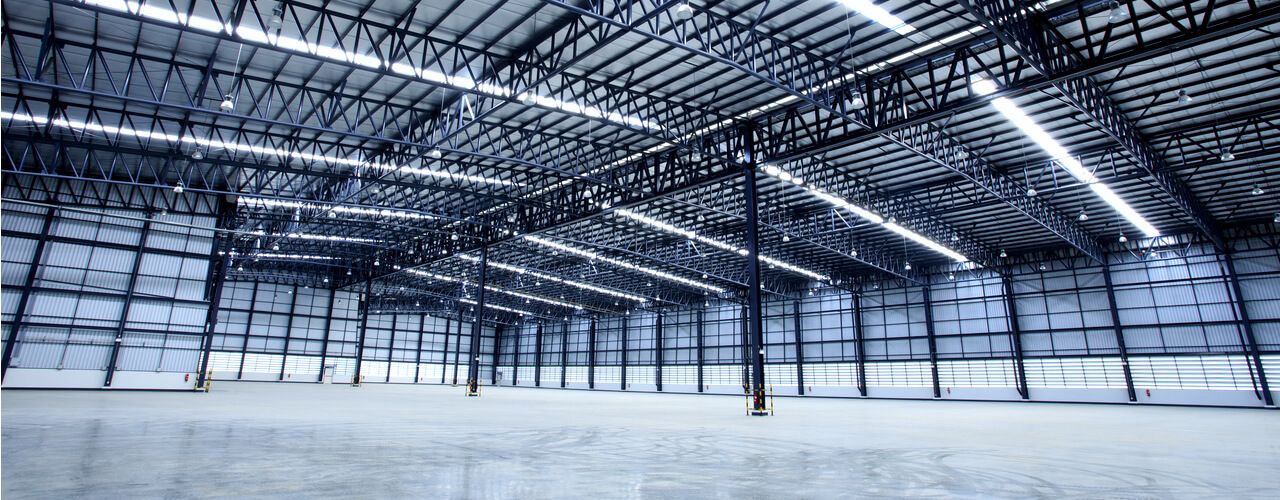Since the pandemic started affecting the U.S. economy last March, industrial real estate has proven to be the bright point in an otherwise challenging real estate market.
As part of CommercialCafe‘s Expert Roundup series, we sat down (virtually, of course) with a number of commercial real estate experts from across the country to get their takes on why the industrial asset class is so resilient, what challenges it still faces, what the near- to mid-future has in store and even break it down to a regional perspective.
Meet our Experts

Grigoriy Azayev
Executive Managing Director & Principal Broker at Stelth Commercial Group

Steve Buss
Industrial Real Estate Expert at Likewise Partners

Marc Civitillo
Managing Director of Acquisitions at SkyREM

Will Curtis
Principal Broker & Instructor at Crossed Sabers Commercial Real Estate & Academy

Fletcher Dilmore
Commercial Advisor at Fletcher Dilmore

Michael Edwards
CRE Analyst at Oxford Companies

Brian Johnson
Managing Director & Senior Associate at Radius Group

Max Levinston
Commercial Real Estate Agent at Kislak Commercial Real Estate Services

Bruce Lowry
Real Estate Partner with Bryan Cave Leighton Paisner

Andrew Maletich
Principal at Cawley Chicago

Lori Roth
Senior Managing Director at Ashley Capital

Bryan Shaffer
Principal/Managing director at George Smith Partners
Industrial construction projects in the U.S. are projected to eclipse 342 million square feet in 2021 – the highest in five years. What are the main drivers of this expansion?
Grigoriy Azayev
“The main drivers of the accelerated expansion we see in industrial construction projects in the U.S. and abroad are the following:
Due to stay-at-home orders and lockdowns throughout the U.S., people had no choice but to shop online for household products, clothing, equipment, and food. The e-commerce and last-mile delivery trend has been emerging rapidly for the last five years, but the pandemic accelerated growth and demand to numbers and targets that no one in the industry expected to see until 2030 (ratio of online sales vs. in-person retail shopping and dollar amounts spent online in purchases).
But the writing was on the wall for quite sometime pre COVID-19. The retail experience has changed dramatically in the last 10 years, and year-over-year, less Americans go to physical brick and mortar stores for everyday consumer goods. Instead, they’re opting for online platforms which have been improving their ease of use, variety of products, and most importantly: delivery speed. It doesn’t pay to get in the car and drive 30 minutes to the store, walk around the store for an hour putting your goods in the cart, and then driving back home, if for the same price, I can click a few buttons and have all my goods delivered – sometimes as quickly as 2 hours.”
Steve Buss
“Right now, three major factors are driving industrial demand — the rise of e-commerce; manufacturing growth due to reshoring; and supply-chain diversification. All three were accelerated due to the pandemic..
E-commerce was a huge driver of industrial real estate expansion before the pandemic and — after a short pause initially in 2020 — it’s only expanded in cities of all sizes.
Industrial real estate demand is a natural reaction of the marketplace, which has doubled down on online sales — not just business to consumer, but also B to B. Corporations are expanding how much they’re willing to buy via e-commerce just like household consumers.
We’re living in a world where competitive delivery pressure is ratcheting up every day. Everyone needs to find warehouse space to help them deliver goods to their customers. They want to offer expedited delivery and develop last-mile e-commerce supply chains to compete against giants like Amazon.
Fulfillment and third-party logistics companies are increasingly in need of distribution centers within a short distance of urban and suburban areas. That’s not going to change. Demand is only going to grow, especially in secondary and tertiary markets. In-fill industrial — as well as new construction — will continue to grow in 2021.”
Marc Civitillo
“E-commerce is the most significant driver of new industrial construction. Online buying and selling of goods has become the driving force with consumer demand for rapid delivery of goods. More logistics space will be required to meet consumer demands; thus, more inventory will be necessary in more locations to reach consumers faster.
Occupiers of industrial properties will continue to expand their warehouse footprints and locations to reach consumers in short periods of time. Consumption of goods will dictate demand and that demand will continue to spur new construction.”
Will Curtis
“The biggest things that has driven the growth in industrial is online shopping and the changes in the consumer purchase process. Between delivery driving the need to last-mile distribution to the click and pick up has increased the need for warehouse space for retailers.
The other thing that is adding to this trend is the move to suburban office space and looking at flex properties to combat COVID concerns like shared common areas, elevators or shared HVAC systems. Flex buildings have the ability to mitigate those issues and have driven the demand for more industrial demand.”
Fletcher Dilmore
“One of the main drivers of this expansion is that traditional big box retailers are conceding market share to online retailers, creating increased demand for industrial warehouse and fulfillment space from these growing online retailers who do not have a traditional physical presence.”
Michael Edwards
“Construction on industrial projects is booming, because we’ve seen consistently that despite periods of economic uncertainty or even crisis, industrial properties tend to remain stable. This means consistent cash flow and reliable investment growth. Industrial may not be the sexiest part of the real estate industry, but it might be the steadiest right now.
Additionally, sectors like e-commerce, data centers, and self-storage have recently seen higher-than-normal demand, and low supply. The onset of the COVID-19 pandemic accelerated the need for infrastructure to support these industries.”
Brian Johnson
“E-commerce is one of the key drivers of the increase in industrial construction projects. Year-over-year growth continues to be in double digit territory and there is no sign of this abating. Additionally, we are seeing the revival of manufacturing in the United States and increased demand from “big box” retailers needing distribution spaces.”
Max Levinston
“Industrial was already growing at a fast pace before Covid, and this pandemic has accelerated many of these trends. In our market warehouse space either for sale or lease is quickly absorbed, both by investors and owner users.”
Bruce Lowry
“In our experience, the drivers in construction has two main drivers, (1) increased demand for warehouse space in general and (2) the lack of modern industrial and warehouse space. Increased demand for industrial warehouse space has significantly increased over the past several years as consumers have increasingly changed their purchasing habits from brick and mortar in person purchases to online orders with door step delivery. The global pandemic has increased this demand for door step delivery of online goods and services including perishable goods such as groceries.
Older consumers were forced to learn new technology and they are learning that they like the convenience of door step delivery. In turn, this increased demand for online ordering and door step delivery has increased the demand for both large warehouse projects and so called last mile warehouse space.
Secondly, outdated building infrastructure including lack of access to technological innovations such as communication and data infrastructure, buildings designed for automated sorting and delivery systems are increasing demand for newly constructed warehouse and manufacturing space. Buildings with narrow spans containing repetitive floor to ceiling support structures simply will not accommodate modern automated manufacturing and warehouse logistics systems and these buildings are being replaced with structures that contain these innovations.”
Andrew Maletich
“ E-Commerce is the primary driver for the high amount of new industrial construction we are seeing now.
COVID-19 has dramatically accelerated the demand for more e-commerce and potentially changed the way consumers buy goods now and in the future. However, e-commerce isn’t the only reason for the increase in new industrial construction. We are starting to see more and more manufacturing coming back to North America. As suppliers dealt with difficulties getting products during 2020 from COVID-19, they realized they can’t be so dependent on getting so many of their products from overseas. Therefore, we are starting to see more “on-shoring” or products started to be produced in USA, Mexico and Canada. All these manufacturers need more industrial space.
Another reason for the increase in new industrial construction is supply chain. Prior to the pandemic, many suppliers were only carrying smaller amount of inventory levels and were left in difficult positions when demand increased. The aftermath of the pandemic will leave many suppliers beefing up their inventory levels to not be in the same position again.
”
Lori Roth
“E-commerce is the primary driver in this industrial expansion. While online shopping had been growing for years, the pandemic was the accelerator in 2020 as people were forced to alter how they purchase. Retailers, particularly discount retail chains, need the big box warehouse space for inventory and last mile distribution centers to get the product to the consumer quickly. A secondary driver was the growth in manufacturing as the global supply chain disruption had companies re-evaluate the geographic footprint of their production. Companies had no choice but to bring manufacturing back on shore.”
Bryan Shaffer
“E-commerce sales was growing before the pandemic, but the crisis accelerated this trend, with consumers unable to obtain goods from some retailers. Further, it was harder for manufacturers and sellers to get their goods to the market therefore many small suppliers have partnered with Amazon to keep their distribution line open. Overall, year over year industrial values increased 8.1% from February 2020 to February 2021, more than any commercial real estate asset class. The E-commerce sales resulted in much stronger demand for logistics and more demand for cold storage space.”
Industrial real estate has fared better that other asset classes in the last year. How has 2020 affected the industrial market this year and beyond?
Grigoriy Azayev
“The industrial market in 2020 has become the sweetheart of CRE. Everyone is chasing industrial deals and some of the biggest players in other asset types are jumping ship to bid on industrial deals. Unfortunately, it is creating a supply shortage in the market throughout the country, and prices for both leases and investments are on the rise. I don’t see this trend slowing down because companies like Amazon have publicly stated they want to double their square footage in the next year and are paying top dollar for class A industrial space and land. Regrettably, it’s weeding out the little guys and small-to-mid-size businesses that also rely on supply chains and logistical real estate.”
Steve Buss
“Another huge factor driving demand for industrial real estate is a much greater awareness of supply chain risk, which was exposed due to the pandemic shutdowns. Shortages of all types of goods revealed just how tight supply chains were for many sectors. For example, some U.S. automakers weren’t able to operate because they couldn’t get onboard computer chips. That led to sustained automotive inventory shortages. Until the pandemic, that was an unseen or under-rated risk in the supply chain. Now, it’s impossible to ignore such risks. Businesses are diversifying those supply chains and rethinking how they manage risk, including where they want to store finished goods.
While it’s typically more profitable to run a really tight supply chain, businesses faced a rude awakening and discovered it’s also much riskier. Businesses and their customers found they were taking on far more risk than they realized by holding very little inventory. They weren’t ready to handle the supply chain disruption. Now, they’re asking how much more inventory they should have on hand to make it through the next supply disruption.”
Marc Civitillo
“The 2020 pandemic prompted an online shopping frenzy for essential goods that fast-tracked the implementation of e-commerce within the economy. Stay-at-home orders in 2020 introduced an entirely new consumer base to e-commerce, and society as a whole has adopted a dependence on e-commerce for basic goods, which has fueled demand for industrial space. This trend will continue for the years to come.”
Will Curtis
“Certainly of returns is always going to drive investments. With large players like Amazon, Walmart, and others that they need additional warehouse space has added to the investment-grade properties and brought in more demand.”
Fletcher Dilmore
“2020 has made industrial real estate an essential asset class. Distribution and warehousing went from being apart of everyday business to being the everyday business. Had it not been for the pandemic, I think it is safe to say we would not have seen as quick of an adaptation of online grocery shopping, something that had been available, but was a minuscule amount of overall grocery sales in previous years. ”
Michael Edwards
“2020 was quite a year – and it was fascinating to see the shifts in the real estate industry. In commercial real estate in general, most markets saw a decline in demand – but industrial saw a significant increase in growth and investment. We anticipate that investors will be eyeing industrial properties favorably in the months ahead.
Part of the reason for this growth in industrial investment is the consumer behaviors that accelerated e-commerce and data centers when the pandemic rocked our worlds last year. Grandparents who’d never ordered anything online before were suddenly getting groceries delivered and medications shipped and birthday gifts sent directly to their kids and grandkids from fulfilment centers. We expect this trend to continue, so demand will remain for the industrial properties needed to support those activities.
”
Brian Johnson
“The appetite for industrial investments predated COVID, especially in Southern California and the coastal regions. But once the country shut down we saw an increased demand for fulfillment centers and investors followed that demand. We expect investors to continue to look toward industrial real estate in 2021 as a primary area for growth and safety.”
Max Levinston
“Online shopping has been a huge reason for the increased demand. Many of these shifts in consumer shopping will not revert back once we’re further out of this pandemic..”
Bruce Lowry
“The industrial and warehouse real estate market is strong and the demand for new industrial and warehouse properties across all sectors will continue as companies innovate and automate their manufacturing, logistics and delivery programs. We see only increases in this sector for the foreseeable future due to high consumer demand for e-commerce goods and the need to continue to automate manufacturing facilities.”
Lori Roth
“I think buying habits have changed for good. Look at how many people converted to online grocery shopping during the pandemic. That directly correlates into the need for cold storage space and I don’t see that trend going away. With Amazon and Walmart sometimes delivering goods within a few hours, consumers are accustomed to getting their packages immediately. The speed with which deliveries are made translates into a need for more last mile distribution facilities throughout the country, particularly in secondary and tertiary markets.”
Bryan Shaffer
“The pandemic forced people to adapt to E-commerce. It likely pushed forward the market in the US by 5-10 years. People who were possibly thinking of looking at eCommerce were forced to utilize it during the pandemic to receive their needed supplies and services. In addition to industrial logistics demand, the vaccine also created more cold storage space. New technology has also developed quicker because of additional capital being invested in this space.”
Are there any other use-types besides e-commerce and cold storage that you see expanding more in the future?
Grigoriy Azayev
“We’re starting to see some secondary uses come into play, such as fleet parking for delivery providers and there has is a growing demand for movie studios and film production campuses in New York City. This is due to some excellent tax incentive programs for film production here and tremendous demand growth for instant and fresh content.
There is also movement in the smaller “maker spaces” and manufacturers here in New York and other cities. The costs of shipping and outsourced manufacturing on the rise, paired with long delays of production due to COVID-19, the cost of manufacturing in the U.S has become comparable to outsourcing due to a growing supply chain. It has become more and more seamless and cost-effective to manufacture all types of goods here in the states.”
Steve Buss
“Another issue that will drive industrial real estate in the years to come is reshoring or bringing manufacturing operations back to the U.S. Because of the pandemic supply chain issues, some companies are less convinced they want all their goods coming from one country like China if they can find local alternatives.”
Will Curtis
“In San Antonio, we are seeing a huge push for Cyber Security. Flex space is showing as a great cost-effective option compared to traditional office buildings. Cyber Security SCIF (Sensitive Compartmentalized Infrastrcture) is expensive to build out and flex gives a lower-cost option. Things like Port San Antonio has been a huge driver for the growth in San Antonio.”
Fletcher Dilmore
“I have seen an increase in demand in my local market for smaller flex space by tenants that have a specialized manufacturing or business specific needs.”
Michael Edwards
“Data centers, undoubtedly, will continue to grow in importance and their needs will evolve along with the technology that’s stored inside them. We’ve also seen self-storage grow over the past few years as a result of more people moving to smaller homes in urban settings. And, self-storage is a sector that tends to resist the overall trends during economic slowdowns – including this COVID-related one. More people than ever before are “working from wherever”, which means they can put their things in storage and hit the road.”
Brian Johnson
“Again, manufacturing has been on the rise lately and “big box” stores continue to show strength, and that will mean both new and expanded fulfillment and distribution centers.”
Max Levinston
“Self-storage and flex spaces.. Many investors are targeting the lucrative nature of self-storage, both industrial conversions and new construction. Flex space is also highly desirable for companies who need a few offices/conference room for staff which is connected to the warehouse.”
Bruce Lowry
“Self-storage and flex spaces.. Many investors are targeting the lucrative nature of self-storage, both industrial conversions and new construction. Flex space is also highly desirable for companies who need a few offices/conference room for staff which is connected to the warehouse.”
Andrew Maletich
“Transportation and logistics companies will continue to expand to meet the growing need for e-commerce and cold storage.”
Lori Roth
“I do think manufacturing will continue to be “on-shored” given the difficulty of getting product from overseas, the backlog at ports in the past year and the Suez Canal blockage. Companies do not have the luxury of waiting for goods anymore and, while they will still manufacture overseas, that production will continue to become a smaller proportion of what they make. They cannot risk relying on other countries for goods as they did pre-pandemic.”
Bryan Shaffer
“Industrial overall is very affordable to build. Over time I expect to see an over-supply. This usually happens with real estate asset classes after they become over heated. I believe that e-commerce will drive more activity and offer a hybrid space between industrial and retail and logistics space will be incorporated into current retail properties. Walmart is an example of a brand where we are seeing this trend now.
The other likely impact on industrial will be the emergence of more food service, commercial kitchens, located within industrial properties, which will service the food delivery companies.”
What’s the #1 challenge industrial is facing in 2021?
Grigoriy Azayev
“The biggest issue that industrial real estate faces is being a follower of the market rather than the leader. It’s great that Amazon can deliver my package to me in under 2 hours here in NYC from one of their many facilities, but if workers don’t return to the office and come back to living in the city, to who will they be delivering these packages? At the height of the pandemic, vacancy rates in NYC for residential buildings touched 25%, and to-date, offices are still at 15% occupancy. These huge investments into last-mile delivery will be a tremendous loss if the theme continues and people don’t return back to NYC.
The second issue is more industrial real estate leads to more air, water and noise pollution, and a substantial increase in traffic. In NYC, there is scarce industrial space and they depend on only a few major roads that trucks can go on to reach the facilities. There are more and more trucks and vans on the road, causing ridiculous traffic, and it’s already become an ongoing concern in the city.”
Steve Buss
“Industrial real estate is one of the few big winners of the pandemic. We see enormous investment potential in industrial properties due to the expansion of e-commerce and the growing demand for warehouse space. We’re expecting growth not just in big cities, but also in secondary markets, particularly in the Midwest.
For tenants looking for industrial properties to lease, it’s very competitive. It’s hard to find space. Due to high demand, industrial rents are going up. When tenants get ready to renew their leases, they’re getting sticker shock. They’re not used to that. That all means, of course, that industrial real estate is a particularly sound investment.
While many bigger box distribution centers are going up in the biggest markets, we see huge potential for developing or building smaller industrial properties closer to urban centers in secondary and even some tertiary markets. You can find 20-, 30- and 40-year-old buildings in excellent locations and make them very functional for multiple tenants. If you stay near urban centers, you can deliver last-mile supply chain accessibility, but also access to workers.”
Marc Civitillo
“The #1 challenge to the industrial real estate sector is the mass appeal for quick delivery. Distributing goods on the same day or the next day requires logistics occupiers to have enough distribution and fulfillment centers close to consumers. The lack of available in-fill, “last mile” industrial properties and developable in-fill sites within urban clusters proves to be the greatest challenge getting goods to consumers in an expedited fashion.”
Will Curtis
“Lack of inventory and pricing smaller users out of the market. I am working with a client now, who is more price-sensitive and we simply can not find space and the few things we do find are more expensive than what can be unwritten into the business plan.”
Fletcher Dilmore
“Keeping up with demand with functional product. Industrial has been the safe haven for real estate investors during COVID, but that doesn’t mean all industrial product is created equal or as equally valuable. There are many industrial buildings across the U.S. that are for practical purposes functionally obsolete. This can be because of low ceiling height, inadequate power supply, difficulty moving trucks in and out, lack of proper sprinkler systems, distance from major transportation arteries, etc.”
Michael Edwards
“We feel really optimistic that challenges will be few for industrial properties this year, at least relative to the opportunities in this part of commercial real estate. But it will be interesting to see how many people miss shopping in brick and mortar stores or having face-to-face interactions, cutting into the growth of e-commerce. We don’t expect that to happen, but it’s something industrial investors should be looking at.”
Brian Johnson
“Logistics and infrastructure for sure. If we do not have the ability to quickly and efficiently move goods around the country and the world then we will see the sector impacted by forces outside its control. This could likely have ripple effects across all sectors.”
Max Levinston
“Supply, the availability is between 1 – 2% right now for quality industrial space, both for lease and for sale.
Developers cannot keep up with the demand which has also caused the prices of industrial land to go up as well. We’re seeing the prices/sq ft go up and some buildings getting leased before construction is completed.”
Andrew Maletich
“I don’t really see any and expect 2021 to be an exceptional year for industrial real estate.”
Lori Roth
“Even with all the new construction, supply is not yet outstripping demand. A significant amount of what is currently being built is already pre-leased. So there is still runway on new development. The issue is going to be finding the land, particularly infill locations. The lack of developable land is causing developers to expand their geographic reach into secondary and tertiary markets.
Land prices continue to rise and construction prices have soared – all of which translates into higher rents for tenants. Tenants often have no choice to be in a specific location so they will need to absorb the higher occupancy costs and industrial will continue to thrive. In terms of existing industrial stock, much of it is now functionally obsolete with minimal trailer staging. The challenge will be how to reconfigure those properties into usable space with features that tenants currently demand.”
Bryan Shaffer
“Developers will race to add more industrial and flex inventory to the market because of the lower cost compared to other types of real estate and the current low vacancy rates. At the same time, overall changes in the retail market caused by e-commerce, will lead to more repurposing of existing better located retail properties into some type of hybrid distribution/ retail projects. Both factors together can lead to oversupply in some markets. Markets with higher land cost and more limited development opportunities will out preform markets with unlimited expansion potential. The long-term need is going to be for better located properties closer to shipping and population centers This will ensure that products can be delivered quicker. For 2021, I believe industrial will overall remain very strong, but the new growth in development may hurt the asset class in the future.”
If you found this article useful and informative, please feel free to check out our Expert Insights & Roundup Series.
If the pandemic and ensuing logistics crisis have taught us anything, it’s that industrial real estate is more important than ever in a world as reliant on trade and transportation. Check out some of the most popular industrial real estate markets in the nation and the properties they have to offer:




[…] Check out the full article here: […]